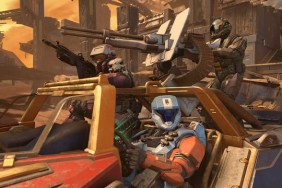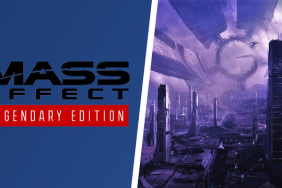Rock Band: On Tour?
First and foremost, a point of clarity: Rock Band: Unplugged should have been called Rock Band: Frequency. Not only does the name “Rock Band: Unplugged” conjure the “please reconnect” image of two guitars, one microphone, and one drum set whose wires are detached from the console, but both Rock Band fans and wannabes will feel deceived. There are no instruments, real or plastic, in Rock Band: Unplugged, unless you count a controller as a musical vessel for finger-tapping. (Does throwing a PSP at a wall count as a one-note streak?)
[image1]However, don’t let that miff you for long. Just think of Rock Band: Unplugged as Frequency (or Amplitude) with a head-to-toe Rock Band skin, or Rock Band with all its songs and internal guts based on Frequency. Besides, not having any peripherals for Rock Band’s first crack at a portable version is well-founded, considering that Guitar Hero: On Tour has what I call a hand vice, which has now also become partially obsolete with the release of the Nintendo DSi.
For those who aren’t familiar with Harmonix’s earlier predecessors for the Guitar Hero/Rock Band phenomenon, Frequency and Amplitude, it’s essentially a game of musical plate-spinning where the plates are the instruments and you keep them spinning by timing notes to your button presses. Imagine that you are playing all four parts of Rock Band by yourself – guitar, bass, drums, and vocals (odd to see vocals as capsules but it works) – cycling through each part so that you don’t leave any one of them alone for too long. Thankfully once you complete several bars of music on one track, that track goes on auto-play for several measures, allowing you to concentrate on the other instruments. (And for you sick have-no-life rhythm geniuses like myself , you can go on a masochistic streak in Band Survival mode which turns the auto-play off.)
The main difference between Unplugged and its origins, as Frequency veterans will note, is that the finger-tapping is now spread across both hands. Instead of just using three face buttons to hit music capsules while using the D-pad to cycle through tracks, hitting capsules has you use left (for red), up (for yellow), triangle (for green), and circle (for blue), while using the shoulder buttons to hop from one track to another. This thoroughly tricky configuration will likely put-off more than a few players, so a Warm-Up mode has been added, a beginner mode that allows players to focus on one track without having to jump from instrument to instrument. But a better idea is to take advantage of the customizable controls and just change it up to your liking.
[image2]The Rock Band wrapping paper, though, is the source of the majority of the changes. Where songs in Frequency and Amplitude could have four or more tracks, Unplugged has strictly four, perhaps to compensate for the difficulty of having four notes on each track instead of three as well as the addition of chords. Each instrument has its own health bar and you’re responsible for keeping each of them alive and healthy. Achieving high scores and five gold-star ratings means keeping your score multiplier high by not missing any notes and seamlessly flipping from track to track. As expected, overdrive (that is, not star power – which Alex Navarro, former editor at GameSpot and now publicist for Harmonix, was quick to point out during our hands-on time) is also important, serving as the only (“score doubler”) substitute for the power-ups in Frequency/Amplitude.
While you’re surfing down the musical road, there will be moments when you enter Solo Mode (for any of the instruments) that mimic the solo riffs in Rock Band. The four tracks collapse into one, focusing on the track with the solo and denying you the option of skipping some parts of it, as you could in Frequency/Amplitude. The transition is seamless and a well-deserved break from having to shift tracks, which I wish was made smoother in some parts. Going from one end to the other means that you have to press the corresponding shoulder button three times (and hope you get to the next note in time), when it might have been easier just to have a shortcut from one end-side of the track to the other.
Also expect to stake your claim to fame in Rock Band fashion, from a lowly band rolling in your grandmother’s van to a worldwide phenomenon that jet-sets from Tokyo to London with screaming fans (and the occasional hipster from Hot Topic who totally thinks you’ve sold out). As you complete song lists, you’ll unlock new venues and earn money to purchase new threads and accessories for your character. You can even use real money to buy tracks (for $1-$2) from the PSP-exclusive online music store, adding to the pre-existing track list of 40 master recordings with nine exclusive songs:
[image3]• 3 Doors Down – "Kryptonite"
• AFI – "Miss Murder"
• Alice in Chains – "Would?"
• Audioslave – "Gasoline"
• Black Tide – "Show Me the Way"
• Blink 182 – "What’s My Age Again"
• Freezepop – "Less Talk More Rokk"
• Jackson 5 – "ABC"
• Tenacious D – "Rock Your Socks"
Where the Rock Band name might backfire, though, is the lack of a multiplayer mode, which some might say is the whole point of Rock Band. Again, in spite of the name, it’s better to treat Unplugged as a derivative of Amplitude, whose multiplayer paled in comparison to the single-player campaign anyway. Of course, you could just imagine some online or local Wi-Fi multiplayer game that has each player control one specific track, or a simple versus mode of some kind. Then again, the choice of editing out some possibly slapdashed multiplayer feature might be well-founded.
Though the Rock Band moniker might be slight marketing ploy, there should be enough flavor that hints from both Rock Band and Frequency for fans of Harmonix to cheer. Look for Rock Band: Unplugged to rock stores on June 9th retailing for $39.99.







